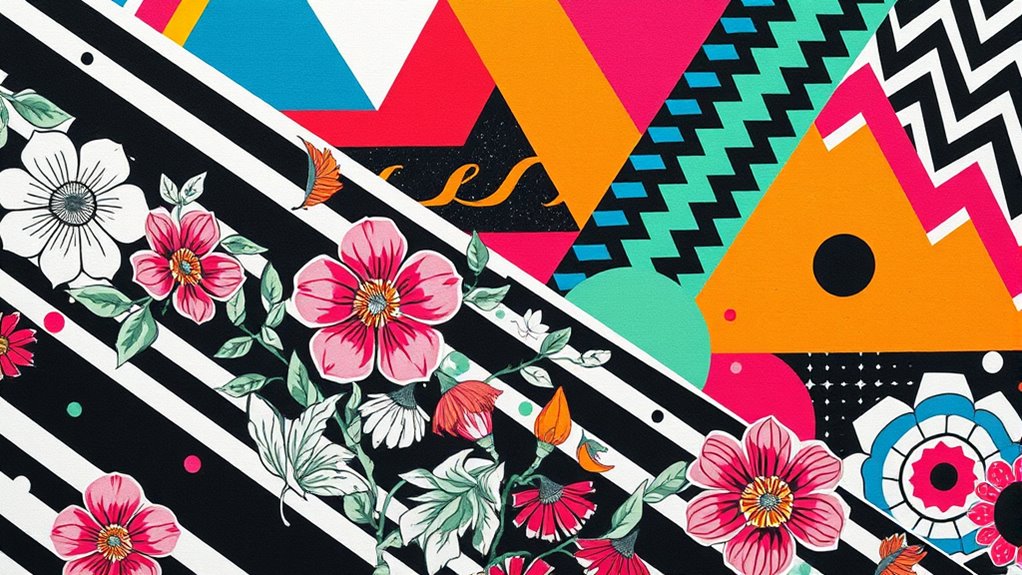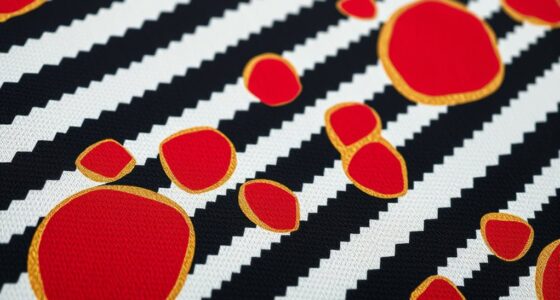To master contrasting patterns like stripes, florals, and geometrics, you should focus on balancing different scales and coordinating colors. Pair bold, large patterns with delicate ones to create visual harmony and avoid chaos. Use cohesive color palettes, such as blues and neutrals or warm tones, to unify the mix. Texture and strategic placement also enhance the overall look. Keep exploring these techniques, and you’ll find easy ways to create eye-catching, stylish combinations.
Key Takeaways
- Balance large floral patterns with fine stripes to create visual contrast without overwhelming the space or outfit.
- Use cohesive color palettes to unify contrasting patterns, ensuring they complement rather than clash.
- Vary pattern scales—pair bold, big designs with smaller, delicate ones for a harmonious look.
- Incorporate different textures and materials to add depth and tactile interest to pattern combinations.
- Arrange patterns thoughtfully, placing focal large patterns strategically and using smaller ones as accents for balance.

Contrasting patterns reveal the diverse ways in which nature, art, and design express themselves through shapes, colors, and textures. When you mix different patterns like stripes, florals, and geometrics, you’re creating a visual dialogue that can energize a space or outfit. The key to pulling off this look lies in pattern balancing and color coordination. Without these elements, contrasting patterns can feel chaotic rather than enthralling. You want each pattern to stand out while still working harmoniously with the others, and that’s where strategic pattern balancing comes into play. It involves choosing patterns with varying scales—pairing a bold, large floral with delicate, narrow stripes, for example—so that no single pattern overwhelms the composition. This balance helps the eye move smoothly across the design, creating a sense of order amidst the visual variety. Additionally, considering the materials used in fabrics can enhance the overall effect by adding subtle contrasts in texture and sheen. Color coordination is equally critical. When mixing contrasting patterns, sticking to a cohesive color palette ensures the overall look remains unified. Think about selecting shades that complement or match across different patterns—perhaps a warm palette of terracotta, cream, and navy, or a cooler scheme with blues, greens, and grays. By doing so, you create a visual connection that ties the disparate patterns together, preventing them from clashing. If you’re feeling adventurous, you can mix patterns with contrasting colors to make a bold statement, but even then, maintaining a consistent color theme helps keep the look sophisticated rather than chaotic. You also want to pay attention to texture, which can add depth and tactile interest to your pattern mix. Combining smooth, shiny fabrics with matte, textured surfaces can enhance the contrast while keeping your overall design balanced. Additionally, consider the placement of patterns—using larger patterns as focal points and smaller ones as accents helps achieve pattern balancing naturally. For example, a floral sofa can be complemented with striped cushions and geometric rugs, creating a layered, engaging aesthetic. Ultimately, mastering the art of contrasting patterns involves more than just throwing different prints together. It’s about deliberate pattern balancing and thoughtful color coordination. When you do it well, you’ll craft a space or outfit that feels lively, dynamic, and uniquely yours. The interplay of shapes, colors, and textures will reflect your confidence in design choices, turning simple contrasts into compelling visual stories.
Frequently Asked Questions
How Do I Choose the Right Pattern Combinations for My Space?
To choose the right pattern combinations, consider pattern scale and contrast. Start with a dominant pattern in a larger scale, then add smaller, contrasting patterns to create visual interest. Mix stripes, florals, and geometrics by balancing bold and subtle designs, ensuring they complement rather than clash. Trust your instincts, and don’t be afraid to experiment—just keep an eye on pattern contrast to maintain harmony in your space.
What Are Common Mistakes When Mixing Different Patterns?
You’ll fall into the trap of pattern overuse if you don’t watch out—trust me, it’s like a visual traffic jam! Avoid clashing scales by mixing tiny florals with bold stripes, not huge with tiny, or your space will look chaotic. Keep balance by limiting yourself to three patterns max, and guarantee they complement rather than compete. Too much pattern overload ruins the harmony you’re aiming for!
Which Patterns Are Best Suited for Small Rooms?
In small rooms, choose patterns with a smaller scale to avoid overwhelming the space. Opt for subtle color contrasts to keep the room feeling open and airy. Mixing tiny florals or delicate geometrics works well, since large, bold patterns can make the area seem cramped. Balance your design by pairing these small-scale patterns with neutral tones or light backgrounds, creating a cohesive look that enhances rather than diminishes your room’s size.
How Can I Incorporate Patterns Into a Minimalist Decor?
Imagine a sleek, crisp white wall accented with subtle texture layering through a single, delicate patterned pillow or a soft throw. You can incorporate patterns into minimalist decor by choosing pieces with muted colors and simple designs, balancing pattern proportion carefully so they don’t overwhelm. Use contrasting textures and subtle patterns sparingly, allowing negative space to breathe. This approach keeps your space feeling fresh, sophisticated, and intentionally curated.
Are There Specific Color Palettes That Work Better With Pattern Mixing?
You should choose color palettes that emphasize color harmony for successful pattern mixing. Opt for neutral backgrounds like beige, gray, or soft whites to keep your patterns coordinated without overwhelming the space. Incorporate complementary or analogous colors to create a balanced look. Avoid overly bold or clashing hues, as they can disrupt pattern harmony. By focusing on subtle color coordination, you’ll achieve a cohesive and stylish mix of stripes, florals, and geometrics.
Conclusion
By mixing stripes, florals, and geometrics, you’re not just creating a look—you’re releasing a visual tornado that demands attention. This bold combination turns your space or outfit into a masterpiece of chaos and harmony, proving that you’re fearless in your style. Remember, when you dare to clash patterns, you’re not just making a statement—you’re rewriting the rules of fashion and design itself. Embrace the madness, and watch your style soar to legendary heights!










